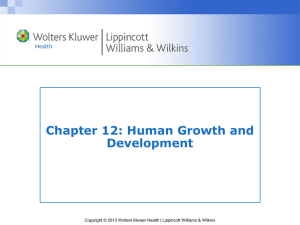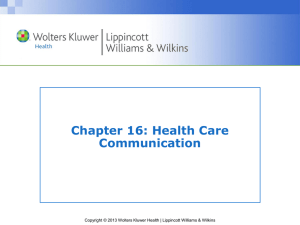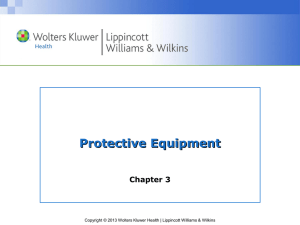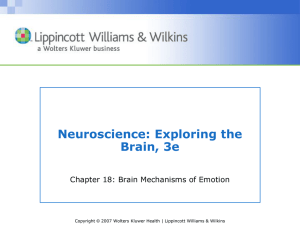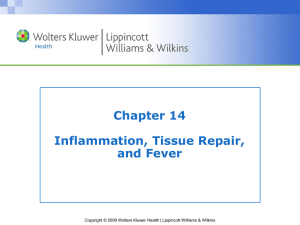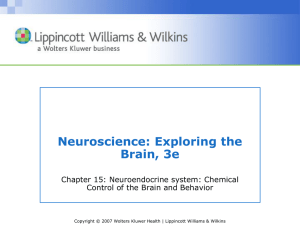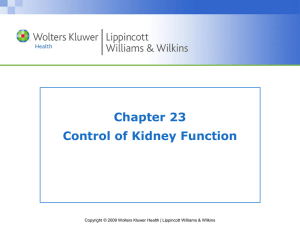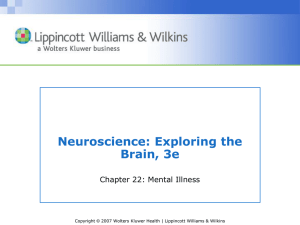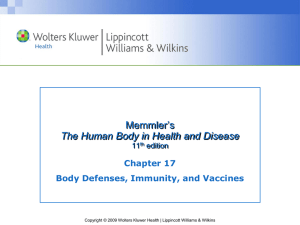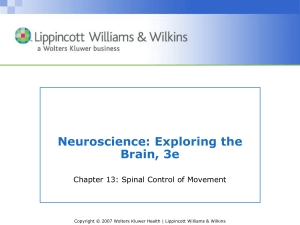Chapter033
advertisement
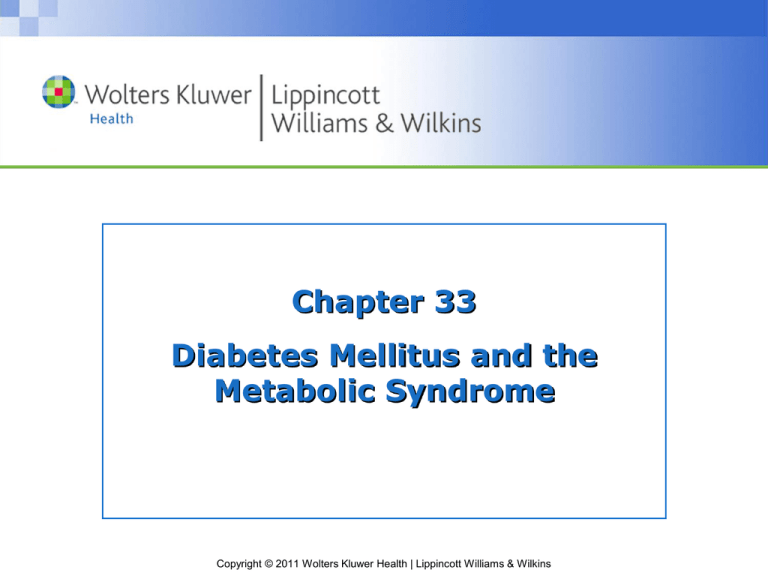
Chapter 33 Diabetes Mellitus and the Metabolic Syndrome Copyright © 2011 Wolters Kluwer Health | Lippincott Williams & Wilkins Anabolism and Catabolism available foodstuffs (in blood) glucose amino acids free fatty acids Anabolism Insulin, anabolic steroids stored foodstuffs (in cells) Catabolism glucagon, epinephrine, cortisol liver can convert amino acids and free fatty acids into ketones Copyright © 2011 Wolters Kluwer Health | Lippincott Williams & Wilkins glycogen proteins triglycerides Insulin and Glucagon Are the Main Controls available foodstuffs (in blood) glucose Anabolism Insulin , stored foodstuffs (in cells) anabolic steroids glycogen amino acids Catabolism Glucagon, proteins free fatty acids epinephrine, cortisol triglycerides liver can convert amino acids and free fatty acids into ketones Copyright © 2011 Wolters Kluwer Health | Lippincott Williams & Wilkins Question Tell whether the following statement is true or false: Anabolic reactions release energy. Copyright © 2011 Wolters Kluwer Health | Lippincott Williams & Wilkins Answer False Anabolic reactions use energy to build/produce/synthesize (like building proteins from amino acids). Catabolic reactions break down substances, releasing energy in the process (like digestion). Copyright © 2011 Wolters Kluwer Health | Lippincott Williams & Wilkins Scenario Two women have benign pancreatic tumors... • In one, the tumor is an insulinoma that secretes insulin • In the other, the tumor is a glucagonoma that secretes glucagon Question • What differences do you expect to see between these two women? Why? • Both of the women have arthritis, but only one is being treated with corticosteroids. Which one? Why is the other not receiving corticosteroids? Copyright © 2011 Wolters Kluwer Health | Lippincott Williams & Wilkins The Pancreas Pancreas Exocrine pancreas Endocrine pancreas releases digestive juices through a duct releases hormones into the blood to the duodenum Copyright © 2011 Wolters Kluwer Health | Lippincott Williams & Wilkins Endocrine pancreas: Islets of Langerhans Alpha cells Beta cells Glucagon Insulin and amylin Delta cells PP cells Somatostatin Pancreatic polypeptide Copyright © 2011 Wolters Kluwer Health | Lippincott Williams & Wilkins Copyright © 2011 Wolters Kluwer Health | Lippincott Williams & Wilkins Functions of Pancreatic Hormones • Glucagon: causes cells to release stored food into the blood • Insulin: allows cells to take up glucose from the blood • Amylin: slows glucose absorption in small intestine; suppresses glucagon secretion • Somatostatin: decreases GI activity; suppresses glucagon and insulin secretion Copyright © 2011 Wolters Kluwer Health | Lippincott Williams & Wilkins Copyright © 2011 Wolters Kluwer Health | Lippincott Williams & Wilkins Question Which pancreatic hormone decreases blood glucose levels? a. Glucagon b. Insulin c. Amylin d. Somatostatin Copyright © 2011 Wolters Kluwer Health | Lippincott Williams & Wilkins Answer b. Insulin Insulin allows cells to take glucose from the blood and use it for energy/to make ATP. Because it stimulates movement of glucose out of the blood and into the cells, blood levels decrease when insulin is released. Copyright © 2011 Wolters Kluwer Health | Lippincott Williams & Wilkins Discussion Think back on your day so far. • When do you think you had your highest insulin levels? • When do you think you had your lowest insulin levels? • When did you have your highest glucagon levels? Copyright © 2011 Wolters Kluwer Health | Lippincott Williams & Wilkins Copyright © 2011 Wolters Kluwer Health | Lippincott Williams & Wilkins Discussion Review the figure on Insulin's Actions • If someone lacks insulin, what happens to his: – Blood glucose levels? – Blood amino acid levels? – Blood pH? – Intracellular fat levels? – Intracellular protein levels? – Cell growth? Copyright © 2011 Wolters Kluwer Health | Lippincott Williams & Wilkins Discussion Review the following diagrams on anabolism/catabolism and insulin's mechanism of action Question • Identify five things that could go wrong to cause increased blood glucose • Which of the cases you identified would be least likely to respond to insulin? Copyright © 2011 Wolters Kluwer Health | Lippincott Williams & Wilkins Anabolism and Catabolism available foodstuffs (in blood) glucose amino acids free fatty acids Anabolism Insulin, anabolic steroids stored foodstuffs (in cells) Catabolism glucagon, epinephrine, cortisol liver can convert amino acids and free fatty acids into ketones Copyright © 2011 Wolters Kluwer Health | Lippincott Williams & Wilkins glycogen proteins triglycerides Types of Diabetes Mellitus • Type 1: pancreatic beta cell destruction predominantly by an autoimmune process • Type 2: a combination of beta cell dysfunction and insulin resistance • Other – Genetic defects in insulin production – Genetic defects in insulin action – Diabetes secondary to other diseases – Drug interactions • Gestational diabetes mellitus Copyright © 2011 Wolters Kluwer Health | Lippincott Williams & Wilkins Pathogenesis of Type 2 Diabetes Copyright © 2011 Wolters Kluwer Health | Lippincott Williams & Wilkins Question Tell whether the following statement is true or false: Type 2 DM is more common than Type 1 DM. Copyright © 2011 Wolters Kluwer Health | Lippincott Williams & Wilkins Answer True Type 1 DM is autoimmune (juvenile diabetes is Type 1), and affects only 5% to 10% of the diabetic population. Type 2 DM is associated with risk factors like obesity, poor diet, and sedentary lifestyle; 90% to 95% of diabetics suffer from this type. Copyright © 2011 Wolters Kluwer Health | Lippincott Williams & Wilkins Metabolic Syndrome • Abdominal obesity • Increased blood triglyceride levels • Decreased HDL levels • Increased blood pressure • Increased fasting plasma glucose Copyright © 2011 Wolters Kluwer Health | Lippincott Williams & Wilkins Copyright © 2011 Wolters Kluwer Health | Lippincott Williams & Wilkins Acute Complications of Diabetes • Diabetic ketoacidosis • Hyperglycemic hyperosmolar nonketotic coma • Hypoglycemia • Somogyi effect • Dawn phenomenon Copyright © 2011 Wolters Kluwer Health | Lippincott Williams & Wilkins Acute Complications of Diabetes (cont.) Discussion • How would hyperglycemia with ketoacidosis cause: – Heavy breathing? – Polyuria? – Dehydration? • Which of these would you not see in hyperglycemia without ketoacidosis? Copyright © 2011 Wolters Kluwer Health | Lippincott Williams & Wilkins Scenario You find a man collapsed on the sidewalk… • He is wearing a diabetic alert bracelet and has an insulin syringe in his briefcase Question • Does he need insulin? • Why or why not? • What signs might help you tell whether he has a hyperglycemic or hypoglycemic problem? Copyright © 2011 Wolters Kluwer Health | Lippincott Williams & Wilkins Chronic Complications of Diabetes Mellitus • Increased glucose levels allow glucose to bind to proteins in: – Hemoglobin Hb A1C has higher O2 affinity – Basement membranes of blood vessels º Nephropathy º Retinopathy º May cause increased risk of atherosclerosis – Lens cataracts Copyright © 2011 Wolters Kluwer Health | Lippincott Williams & Wilkins Copyright © 2011 Wolters Kluwer Health | Lippincott Williams & Wilkins Osmolarity in Diabetes Mellitus • When blood glucose is high, increased blood osmolarity can cause cells to shrink • Nerve cells produce intracellular osmoles to keep their osmolarity balanced with the blood • When the client brings blood glucose back to normal, the nerve cells are hyperosmolar to the blood and gain water, swelling • Nerve damage may be caused by swelling, demyelination, and lack of O2 secondary to vascular disease Copyright © 2011 Wolters Kluwer Health | Lippincott Williams & Wilkins Diabetic Neuropathy • Somatic neuropathy – Diminished perception of vibration, pain, and temperature – Hypersensitivity to light touch; occasionally severe “burning” pain • Autonomic neuropathy – Defects in vasomotor and cardiac responses – Impaired motility of the gastrointestinal tract – Inability to empty the bladder – Sexual dysfunction Copyright © 2011 Wolters Kluwer Health | Lippincott Williams & Wilkins Question Which of the following is not a complication of diabetes mellitus? a. Nephropathy b. Retinopathy c. Neuropathy d. All of the above are complications of DM. Copyright © 2011 Wolters Kluwer Health | Lippincott Williams & Wilkins Answer d. All of the above are complications of DM. Nephropathy and retinopathy are caused by increased blood glucose levels that cause binding of excess glucose to the basement membranes of the blood vessels of the kidneys and eyes. Neuropathy is due to swelling and demyelination of nervous tissue. Copyright © 2011 Wolters Kluwer Health | Lippincott Williams & Wilkins

